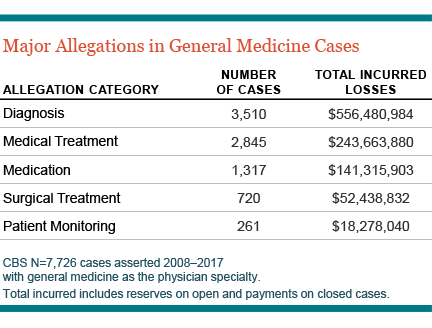Article
Risks in General Medicine: Primary Allegations

What’s My Risk?
Primary Allegations in Medical Malpractice Claims Against General Medicine Clinicians: How to Protect Your Patients and Yourself
As a physician, your goal is to deliver the safest, most high-quality care possible for your patients. Yet in the fast-paced delivery of health care, sometimes things don’t go as planned. In the worst-case scenario, a medical error or oversight can lead to harm, or even death, for a person under your care. This may result in a claim of medical malpractice.
Safety in Numbers
One way to protect yourself—and to ensure the best possible outcome for your patients—is to understand the most common types of allegations filed against general medicine practitioners. CRICO's national Candello Data (previously known as CBS) captures 30 percent of all medical professional liability cases across the U.S., providing a wealth of data that can help you identify your biggest areas of malpractice risk. Using that same data, CRICO has developed a broad inventory of risk mitigation resources intended to offer clinicians opportunities for improvement.
The Impact of Medical Error in General Medicine

Deep analysis of cases from 2008 to 2017 involving 7,726 general medicine physicians—specializing in internal medicine and family practice—reveals that the most common allegations of negligence stem from breakdowns in the diagnostic process followed by cases related to medical treatment and medication errors.
Top Three Major Allegations in General Medicine
CRICO has been tracking this process for years based on the common occurrence of systemic and cognitive errors, including missed or delayed diagnosis of cancer, communication failures, and test result management. Directed by the insights delivered by MPL data, you can tap into CRICO’s many resources to help ensure you are armed with knowledge which can help mitigate your risk of avoidable diagnostic errors.
- Diagnosis-related: Breakdowns or oversights in the diagnostic process are the most frequently named allegations (3,510 cases over a 10-year period) against physicians practicing general medicine. Such errors could stem from problems with communication, such as not sharing test results with patients and/or other care team members, problems with referrals, and problems around ordering and following up with testing in the most appropriate timeframe and manner.
- Medical treatment: Issues with medical treatment given to a patient is cited in 2,485 cases, making it the second most likely allegation against general medicine physicians. This complaint can be related to anything from not ordering the right treatment, to not administering it properly, to poor oversight in monitoring the result
- Medication-related: Errors in medication were named in 1,317 cases, making it the third most common allegation listed against general medicine providers. Medication errors can include giving the wrong medicine, giving the medicine to the wrong patient, or prescribing the wrong dosage.
Protect Yourself and Your Patients
The following steps can help you strengthen your practice in these areas. For instance:
-
Use current decision support tools to help you avoid harming your patients by missing or delaying a diagnosis. One such tool is CRICO’s recently updated Breast Care Management Algorithm.
-
Take a thorough patient and family history, and update this information regularly, to identify patients with an increased risk of cancer and other serious conditions and use this information to guide the diagnostic process.
-
Employ a systems-based process or use organization-wide standards to ensure that all clinicians follow the latest testing recommendations and also share the results with other member of the patient’s treatment team so nothing will be overlooked.
-
Comprehensively track and coordinate each patient’s ongoing medical care and/or treatment and any follow-up steps needed.
-
Practice active listening to make sure you are capturing all of the details in your patient stories. Also, keep the diagnostic process open until you have enough supportive information to be conclusive.
When you use CRICO Strategies CBS data and best practices to drive your actions, you can close the gaps in your current processes. This will ensure you’re providing a culture of safety for your patients and reducing your risk of being sued for medical malpractice.
Learn More
- 2018 Candello Report: Medical Malpractice In America
- CRICO’s 12-Step Diagnostic Process of Care Framework
- Expecting Diagnosis Errors
- Primary Care Docs Try to Up Their Diagnosis Game
- Safety Culture and Risk Reliability in Health Care
Related Articles
Risks in General Medicine: Contributing Factors


What’s My Risk Library

Risks in Surgery: Primary Allegations

